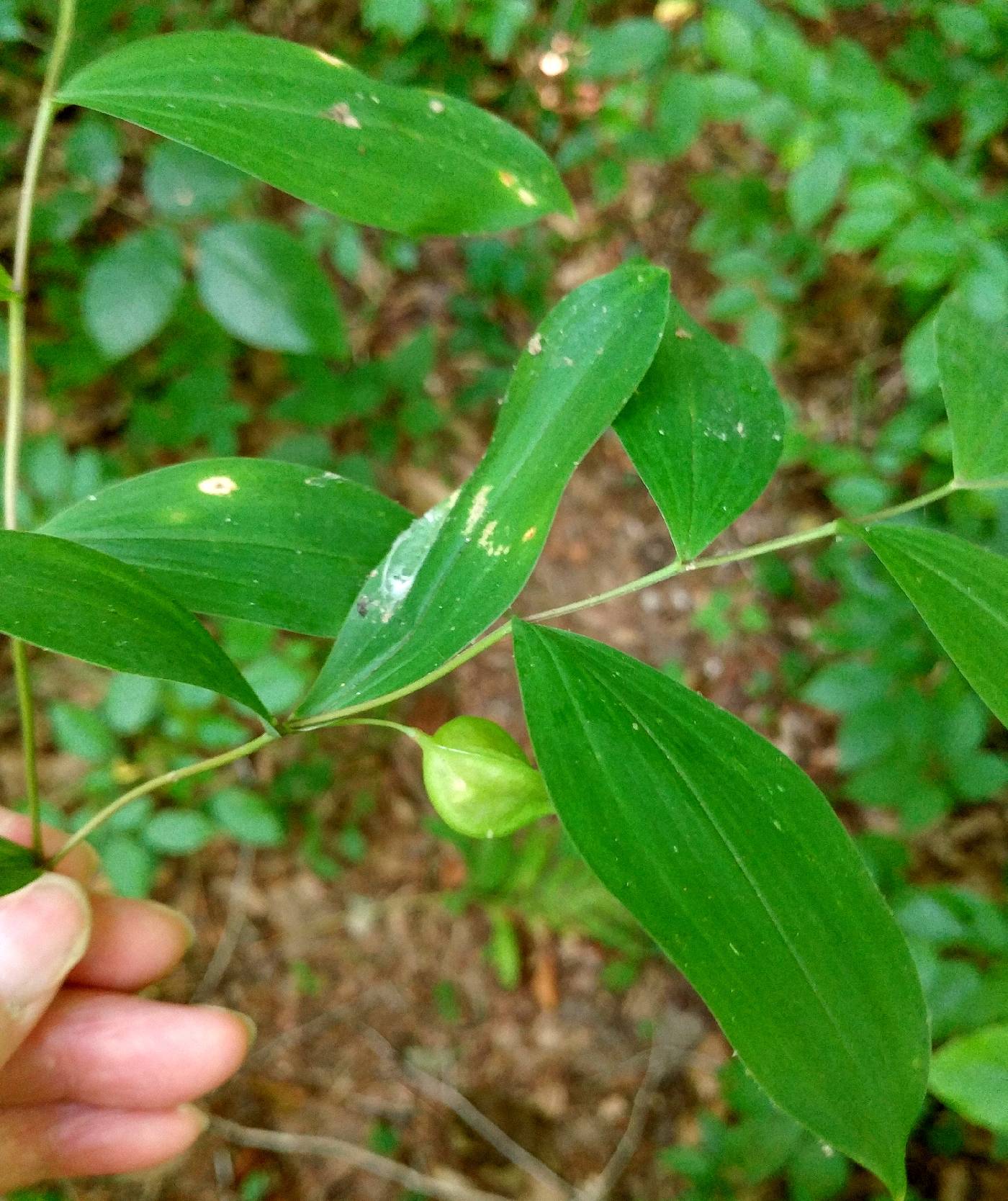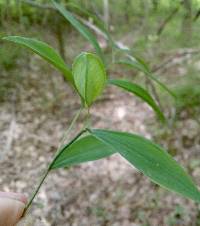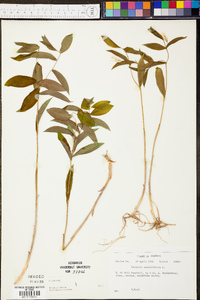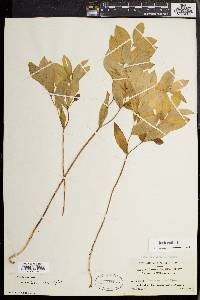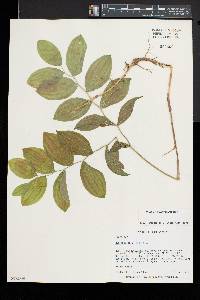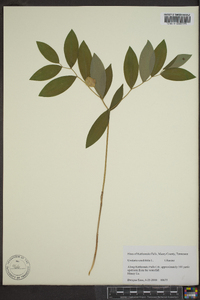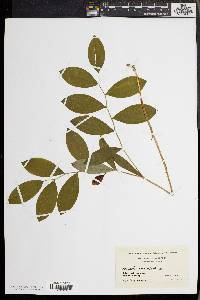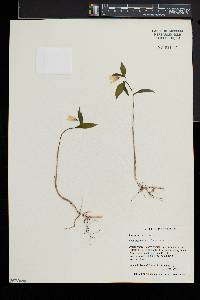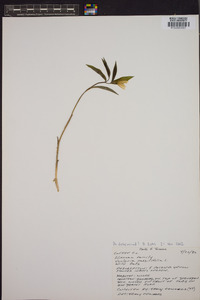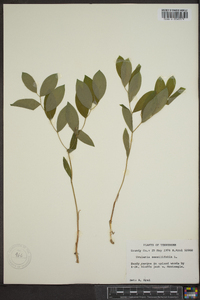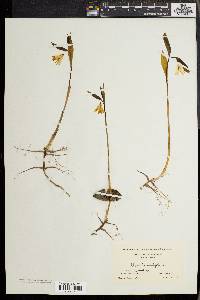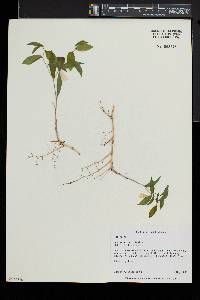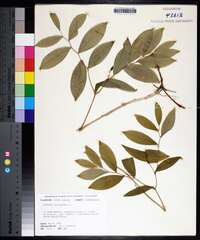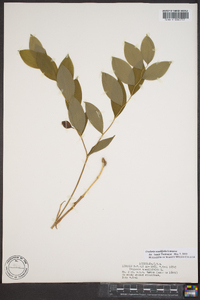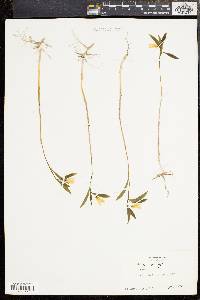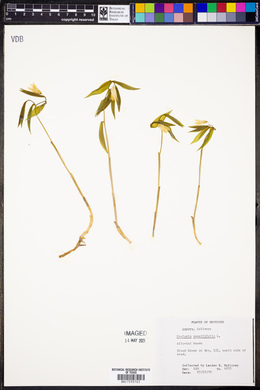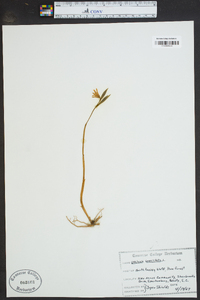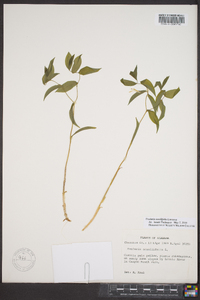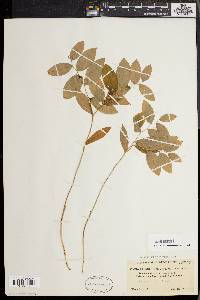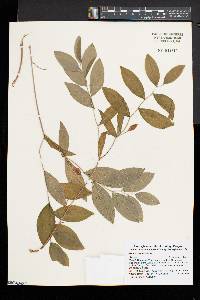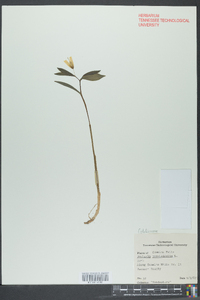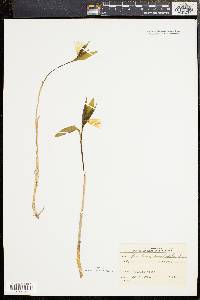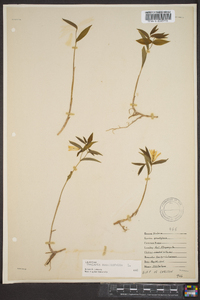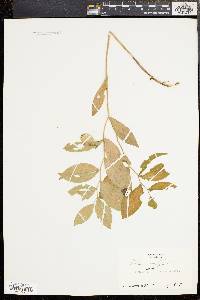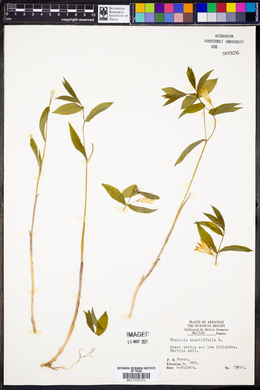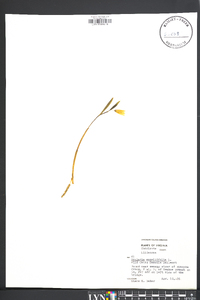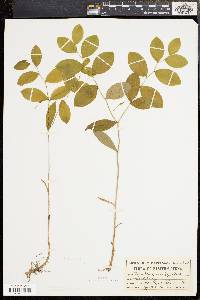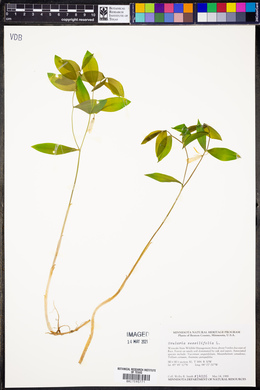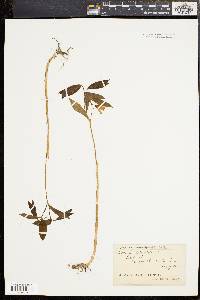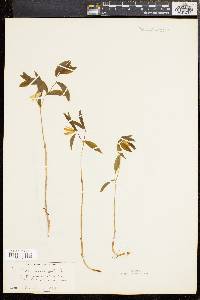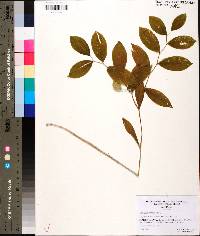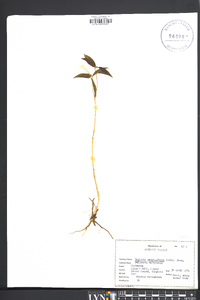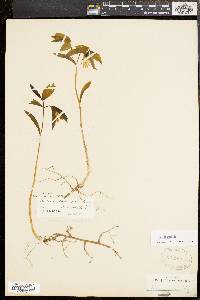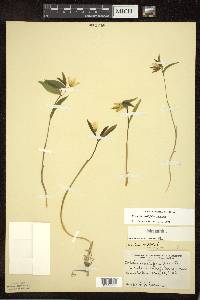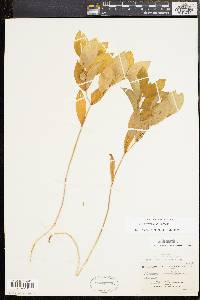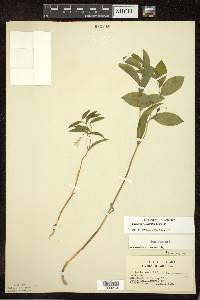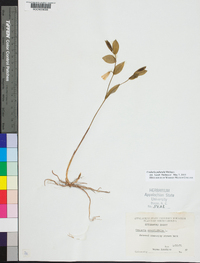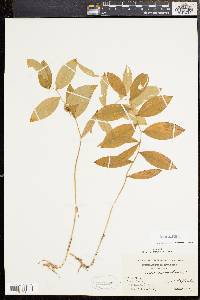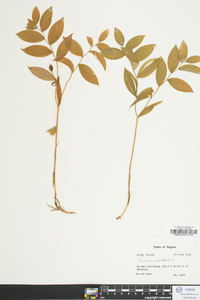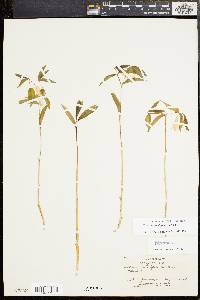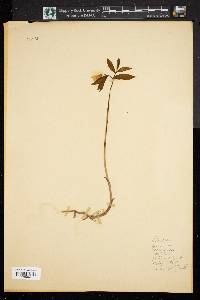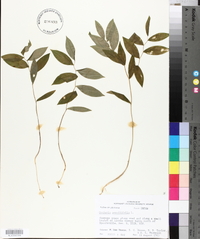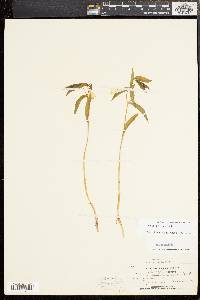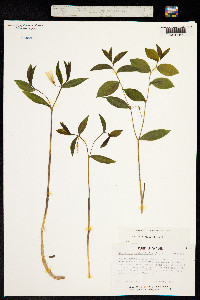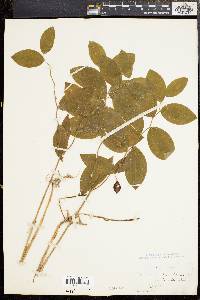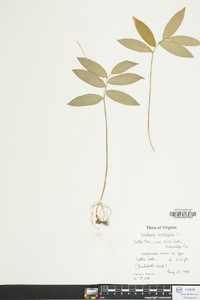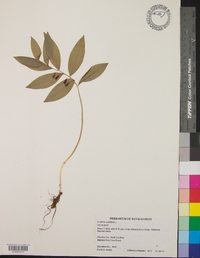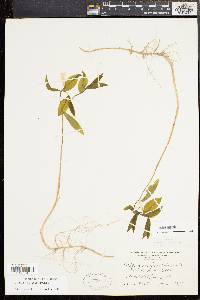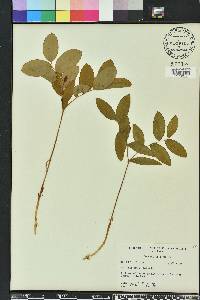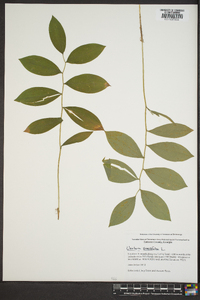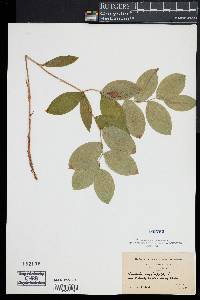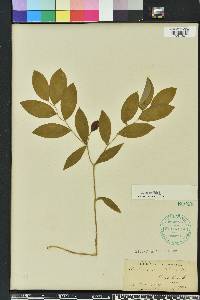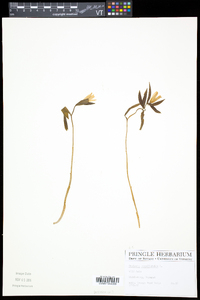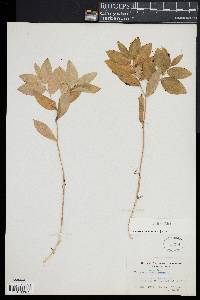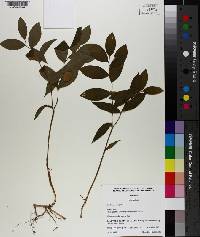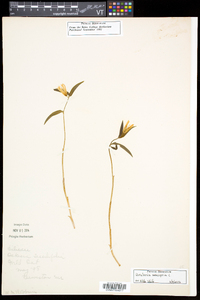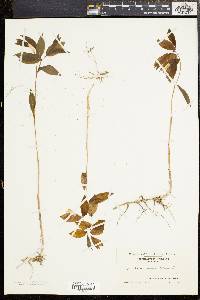
|
|
|
|
Family: Colchicaceae
Sessile-Leaf Bellwort, more...sessileleaf bellwort
[Oakesia sessilifolia S.Watson] |
Rhizomes elongate, slender, 10-15 cm, bearing scattered, fibrous roots; stolons present. Stem 1, 1-branched, angled distally, 1-4.5 dm, nodes glabrous, bearing 1-2 leaves below lowest branch. Leaf blades sessile, narrowly to broadly elliptic, 4-6.5(-8) × (1.3-)1.6-2.8(-4) cm, glabrous abaxially, margins minutely denticulate, apex acute to acuminate. Flowers 1 per stem; peduncles 0.6-1.6 cm, ebracteate; tepals pale straw-yellow, 13-25 × 2-4.5 mm, smooth abaxially, apex rounded to acute; stamens 8-15 mm; anthers 5-12 mm; connectives 0.3-0.5 mm; ovary stipitate, sharply triangular, flowering stipe 0.8-1.2 mm; style 10-15 mm; stigma lobes 1-2 mm. Capsules sharply 3-winged, stipitate, ellipsoid, 2-3 × 1-1.6 cm, not beaked; fruiting stipe 2-5 mm. Seeds 3-5 mm; arils crested. 2n = 14. Flowering spring--early summer. Moist hardwood coves, alluvial bottomlands, thickets and xeric woods northwards; 0--1000 m; Man., N.B., N.S., Ont., Que.; Ala., Ark., Conn., Del., D.C., Fla., Ga., Ill., Ind., Iowa, Ky., La., Maine, Md., Mass., Mich., Minn., Miss., Mo., N.H., N.J., N.Y., N.C., N.Dak., Ohio, Okla., Pa., R.I., S.C., Tenn., Tex., Vt., Va., W.Va., Wis. Perennial herb with a elongate, slender rhizome stem 10 - 45 cm tall Stem: one, one-branched, upright, forked above the middle, with sheathing bracts at the base. Leaves: alternate, stalkless, 4 - 6.5 cm long, 1.5 - 3 cm wide, oblong lance-shaped to elliptic with a pointed tip, minutely toothed, with a waxy coating (glaucous) on the lower surface. One or two leaves grow beneath the fork of the stem. Flowers: one per stem, terminal (but appearing axillary), nodding, pale straw-yellow, narrowly bell-shaped, with six distinct tepals. Tepals over-lapping, 1.2 - 2.5 cm long, 2 - 4.5 mm wide, elongate, with a pointed tip. Flower stalk 0.6 - 1.6 cm long. Stamens six, 8 - 15 mm long. Fruit: a sharply three-winged capsule, distinctly stalked, greenish to yellowish brown, 1.5 - 3 cm long, 1 - 1.6 cm wide, ellipsoid. Seeds brownish red, nearly spherical. Similar species: The similar Uvularia grandiflora and U. perfoliata differ by having perfoliate leaves. Flowering: April to June Habitat and ecology: Rare in the Chicago Region. A substantial population was discovered in Porter County, Indiana growing in full sun between thickets in a cutover area. Typically found in rich woods. Occurence in the Chicago region: native Etymology: Uvularia comes from the word uvula (the soft lobe that dangles at the back of the throat) of which the drooping flowers resemble. Sessilifolia means stalkless. Author: The Morton Arboretum Stem 1-3 dm at anthesis, bearing 0-2 lvs below the fork and only 1 or 2 fls; lvs at anthesis lance-oblong, acute at both ends, glaucous beneath, at maturity elliptic, to 8 נ3 cm, obtuse or rounded at base, nearly smooth on the margins, tep pale stramineous, 12-25 mm; styles connate for three-fourths their length; about equaling the perianth, much exceeding the anthers; fr 3-angled, distinctly stipitate, 15-20 mm; 2n=14. Woods; N.S. and N.B. to Minn. and S.D., s. especially in the mts., to S.C., w. Fla. and La. Apr., May. (Oakesia s.; Oakesiella s.) Gleason, Henry A. & Cronquist, Arthur J. 1991. Manual of vascular plants of northeastern United States and adjacent Canada. lxxv + 910 pp. ©The New York Botanical Garden. All rights reserved. Used by permission. From Flora of Indiana (1940) by Charles C. Deam Colonies are infrequently found in the southern counties where it grows in hard, clay soil, usually associated with beech, beech and sweet gum, and lowland oaks. It propagates mostly from the rootstocks and a note on one of my labels reads: "I found, in a low woods about 3 miles southwest of Dale, Spencer County, two colonies about 10 X 20 feet and this species formed a mat over these areas." …… Indiana Coefficient of Conservatism: C = 6 Wetland Indicator Status: FACU |
This project was made possible in part by the Institute of Museum and Library Services [MG-70-19-0057-19].
Powered by Symbiota

